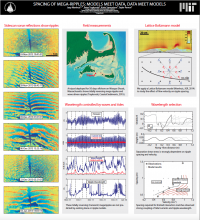CSDMS 2015 annual meeting poster JaapNienhuis
Wavelength selection of tidally reversing mega-ripples, field observations and comparison with numerical flow modeling
Peter Traykovski, WHOI, Woods Hole, United States.
Katie Samuelson, MIT-WHOI, Cambridge, Massachusetts, United States.
Taylor Perron, MIT, Cambridge, Massachusetts, United States.
Abstract:
Ripples formed by waves and tides are ubiquitous in coastal environments. Recently, significant advances have been made to understand the basic controls of waves on ripple geometry. However, due to the difficulty of making field measurements and the long timescales over which tidal velocity amplitudes change, our understanding of the controls of tides on ripples has thus far been restricted. An improved understanding of the wave and tidal controls on ripple geometry can improve models of coastal sediment transport, and, through study of ripples preserved in the sedimentary archive, help to determine paleoenvironmental conditions. In this study, we combine field observations of ripples with a detailed numerical flow model to investigate tidal controls on ripple wavelength.
Using almost two months of continuous observations of ripples obtained offshore of Martha’s Vineyard, we find a surprising dependence of ripple wavelength on tidal velocities. The wavelength during neap tide conditions is 0.4 m, when the maximum tidal velocities are 0.6 ms-1. At spring tide, with tidal currents of about 1 ms-1 close to the bed, the wavelength grows fivefold to more than 2 m. Because these ripples reverse every half-tidal cycle, and because the ripple wavelength is substantially longer than current ripples, we call these features tidally reversing mega-ripples. We have used a lattice Boltzmann model of turbulent flow across these features to study the influence of tidal currents on the flow separation zone downstream of the crest. For single ripples, flow velocities have a negligible influence on the separation vortices that develop. This is in agreement with flume observations and earlier numerical models of flow across bed forms. Surprisingly, however, when we place two ripples behind each other, we observe that vortices being shed off the upstream ripple increase the shear stress at the ripple crest downstream. We found that there exists a critical spacing at which the crest shear stress, and by extension, ripple migration rate, are equal for two subsequent ripples. This critical spacing coincides with our field observations of ripple wavelength during tidal conditions.
* Please acknowledge the original contributors when you are using this material. If there are any copyright issues, please let us know and we will respond as soon as possible.

